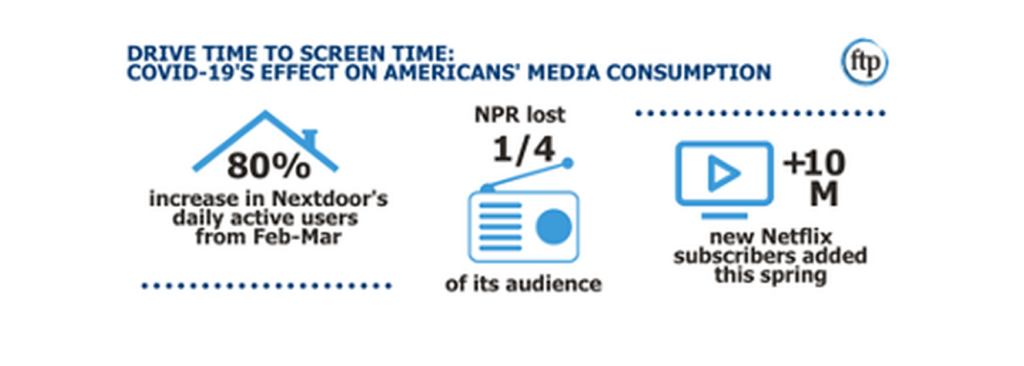
American habits and values have shifted greatly since stay-at-home and shutdown orders began in March, with major implications for organizations trying to raise awareness and drive public conversation about their issues. While it’s clear the novel coronavirus has changed Americans’ habits and increased virtual connectivity in new ways, it has also altered how we consume and share information.
FTP dove into recent research and data points to better understand how the pandemic has shaped our media preferences and consumption. We found that certain media formats have been “winners” and are critical to consider as organizations navigate how to communicate and engage the public.
- As the pandemic has moved us into a “no touch” culture, Americans are looking for easy access to online news rather than print news. In March 2020, online news consumption increased by 215 percent from the previous year. (Nielsen, 6/16/20)
- An increasing amount of online news consumption takes place on mobile devices. Between January and April of 2020, daily installs of online news apps grew by 37 percent, with a peak in March. Daily sessions – the period of time wherein a user interacts with an app – also increased 59 percent. (New Digital Age, 6/25/20)
- Americans are using social media to fill the void of in-person contact caused by social distancing and stay-at-home orders.
- In May, 51 percent of surveyed U.S. adults reported increased usage of certain social media platforms. Adults 35 to 49 years old increased their usage the most, with a 64 percent reported increase. (Business Insider, 6/9/20)
- By the end of March, messaging across Facebook, Instagram, and WhatsApp had increased 50 percent in countries hit hardest by the virus. And in the first quarter of 2020, the total number of Twitter users increased 23 percent from the same time last year. (JP Morgan, 5/1/20)
- Included in this social media spike are more “calls to action.” Change.org saw an unprecedented number of people taking action through online petitions: there were about 57 million signatures just on virus-related petitions for the first two months of coronavirus shutdowns. (WXYZ, 5/14/20)
- Other forms of localized, community-focused social media have also become more popular. Nextdoor, a social app and website meant to connect neighbors, saw its global daily active members increase more than 80 percent from February to March. (PR News, 3/20/20)
- Alongside neighbors’ online interaction, community members are consuming more local news.
- Nearly six in ten (58 percent) Americans surveyed in March reported consuming more local news after the pandemic began, including 38 percent who said they did not watch local news before the crisis hit. (Horowitz Research, 4/1/20)
- In fact, 61 percent of U.S. adults reported paying equal attention to both national and state and local coronavirus news. About a quarter (23 percent) are paying closer attention to state and local elements of the outbreak, while 15 percent are most engaged in national-level news. (Pew Research Center, 4/29/20)
- Perhaps the most time-intensive form of media consumption has come through streaming platforms.
Meanwhile, other forms of media have been left behind or altered dramatically as Americans’ daily – and thereby media – habits change.
- Podcast usage has fluctuated. Initially podcast listening was down in the United States after coronavirus struck, then started picking back up. Virus-related podcasts have flooded the airstreams, however. (Podtrac, 6/1/20; Podnews, 3/23/20)
- Usage of music streaming services like Spotify have also fluctuated. Spotify has underperformed in terms of streaming expectations for 2020. With people spending less time commuting and at the gym, American streaming dropped 12 percent in April. (Barron’s, 4/6/20)
- As Americans cut their driving time, their radio consumption is lower. National Public Radio (NPR) shows lost roughly a quarter of their audience between the second quarter of 2019 and the same months in 2020. (NPR, 7/15/20)
Overall, Americans have sought out more news and increased their usage of various forms of online, mobile, social, and streaming media. Notably, the most popular forms of media in recent months all appear on a screen, and they deviate from traditional news outlets. Just as advertisers, broadcasters, and the government shifted their methods of communication during and after World War II, we must take note of new consumer trends at this current – and albeit, unprecedented – watershed moment in our nation’s history. Shifts in media consumption should encourage organizations to rethink how they disseminate their messaging into today’s world.
Forbes Tate Partners is a bipartisan, integrated full-service public affairs consultancy specializing in government relations, traditional and digital communications, grassroots advocacy and third-party coordination, coalition management, and business development. FTP can help you develop and deliver winning strategies to communicate and engage your key audiences.
